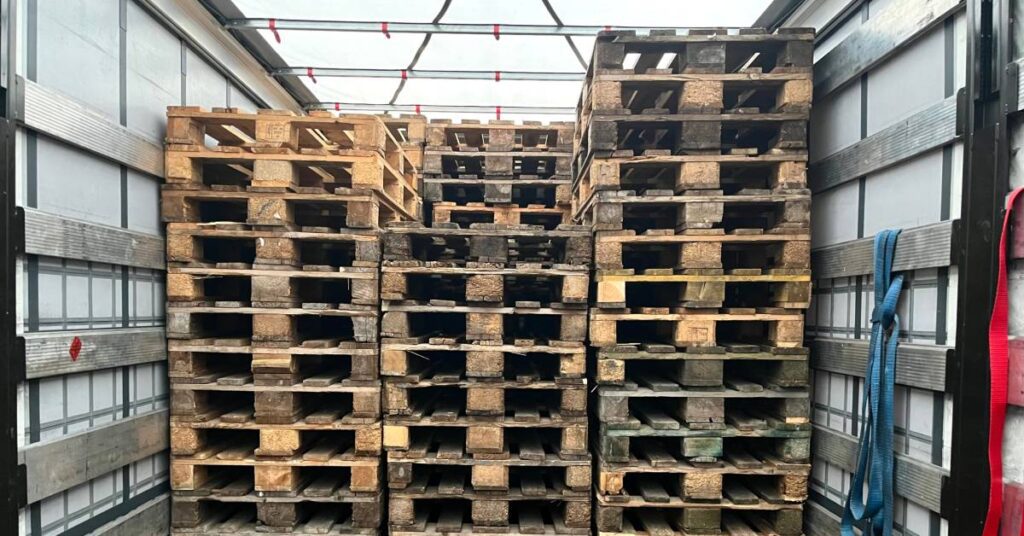Many logistics and industrial workplaces use heat-treated pallets. The pallets protect goods, comply with international regulations, and maintain smooth and safe transportation.
However, what makes heat-treated pallets so special? How do they differ from other wooden pallet options? Logical Logistics is here to help answer some of these questions with our complete guide to heat-treated pallets.
We aim to highlight everything from their importance to the manufacturing processes behind them. The more you know about heat-treated pallets, the more you can improve your business operations.
What Are Heat-Treated Pallets?
Heat treatment is a process that helps pallets meet international standards for pest control. Average pallets can harbor insects and microorganisms. Heat treating sanitizes the pallets to help eliminate these risks. Not only is this process necessary for safe, international transportation, but it extends the pallets’ lifespans by reducing their degeneration from common pests.
Heat treatment for pallets involves exposing wood to high temperatures in a regulated environment. The result is a durable, sanitized pallet that meets stricter shipping requirements. This process helps make pallets especially valuable in international shipping and helps prevent the spread of pests across borders.
The Importance of Heat-Treated Pallets in Global Trade
International trade involves moving goods across countries with their own regulations and rules. Many countries adhere to phytosanitary standards that prevent the transfer of pests and diseases through wood packaging materials. Naturally, heat-treated pallets make it easier to adhere to these regulations.
The International Standards for Phytosanitary Measures No. 15 (commonly referred to as ISPM 15) outlines the guidelines for treating wood packaging materials for international shipments. Compliance with ISPM 15 ensures that goods packed on heat-treated pallets can enter foreign markets without delays related to customs restrictions. Failing to meet these standards may result in rejected goods, quarantined shipments, or complete destruction of goods, leading to financial and operational setbacks.
Logistics managers need to use pallets that meet these requirements to streamline the shipping process. Heat-treated pallets reduce the risk of noncompliance penalties and may positively affect your business reputation in international markets.
What Is the Heat Treatment Process?
Now that we know what heat-treated pallets are, let’s take a look at the process itself. It begins with raw wood that’s cut into the necessary pallet components. After assembly, these pallets go into a specialized heat treatment chamber.
The chamber reaches controlled high temperatures for a specific time period. These chambers generally reach a minimum temperature of 56 degrees Celsius or 132.8 degrees Fahrenheit for at least 30 minutes. The heat eliminates insects, larvae, mold, and fungi that may be present in the wood. The duration and temperature can vary depending on the thickness and species of the wood.
After completing the process, the treated pallets receive a unique stamp to indicate their compliance with ISPM 15. Additional stamp details include a symbol, country code, heat treatment code, and registration number to identify the facility that treated the pallet.

Benefits of Using Heat-Treated Pallets
As we already mentioned, these pallets streamline compliance with international shipping regulations and greatly reduce the likelihood of rejected shipments.
On top of that, heat-treated pallets are more durable. Heat strengthens the structure of the wood, giving it extra resistance to warping, cracking, and certain environmental factors. Heightened durability means businesses can reuse pallets multiple times, reducing the need for frequent replacements or repairs.
Heat-treated pallets can also contribute to a company’s sustainability goals. Heat treatment eliminates the need for chemical fumigation, which can have harmful environmental effects. This makes heat-treated pallets an eco-friendly choice for businesses wanting to lessen their environmental impact.
How Heat-Treated Pallets Improve Safety
Safety is a top priority in logistics, especially when dealing with fragile or perishable goods. Heat-treated pallets play an important role in ensuring the secure transportation of products. Shipping industries can reduce the risk of contamination and protect the integrity of their shipment by removing pests and microorganisms.
The added durability of heat treating a pallet decreases the likelihood of pallet breakage during handling. This extra strength prevents accidents and product damage. Fewer accidents can result in reduced liability risks and improved operational efficiency.
Comparing Heat-Treated Pallets to Other Pallets
While there are other types of pallets available—such as chemically treated and plastic pallets—heat-treated pallets stand out for their versatility and compliance with regulations. Chemical treatments also successfully eliminate pests but come with environmental concerns. Plastic pallets are not biodegradable, and they cannot hold heavy loads as well as heat-treated wooden pallets can.
Heat-treated pallets are the most sustainable, durable, and economic options. They are natural, versatile, and able to withstand heavier loads while adhering to international standards. The culmination of their benefits is why they remain a preferred option for those seeking effective and sustainable solutions.
Cost Implications of Heat-Treated Pallets
A common concern about these pallets is the cost of the heat-treatment process or buying pretreated pallets. While heat-treated pallets may have a high upfront cost due to the treatment process, their durability and reusability offer cost savings over time.
Businesses can reduce the frequency of repairs and replacements by investing in heat-treated pallets. The long-term financial benefits outweigh the initial expenses, making heat-treated pallets a cost-effective choice for many operations.

Repairs and Reusability of Heat-Treated Pallets
It’s inevitable for some pallets to experience damage in transport. When repairs are necessary repairs, heat-treated pallets are easy to repair.
Companies will need to make sure that the repaired pallets continue to comply with ISPM 15. This may require retreatment and reevaluation of the repaired pallet.
The reusability of heat-treated pallets further enhances their value. Businesses can implement a pallet return system to maximize usage, reduce costs, and maintain a steady supply of compliant pallets.
Choose the Right Supplier for Heat-Treated Pallets
Selecting the right supplier is a critical step for logistics managers. A reliable supplier should offer certified heat-treated pallets that meet ISPM 15 standards and documentation to guarantee that the pallets are up to code. Evaluating a supplier’s experience, reputation, and customer reviews can provide valuable insight into their reliability.
Discover how Logical Logistics can streamline your operations with high-quality, heat-treated wooden shipping pallets. We hope that our complete guide to heat-treated pallets has helped you make an informed decision that benefits your business. Contact us today to discuss your supply chain needs and find the perfect shipping solution.

